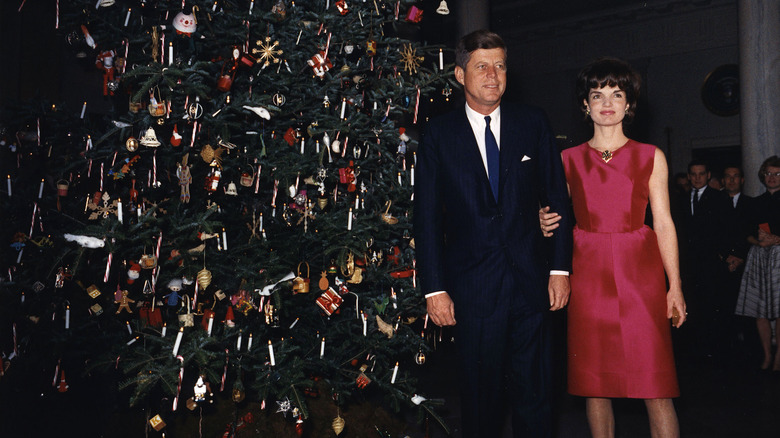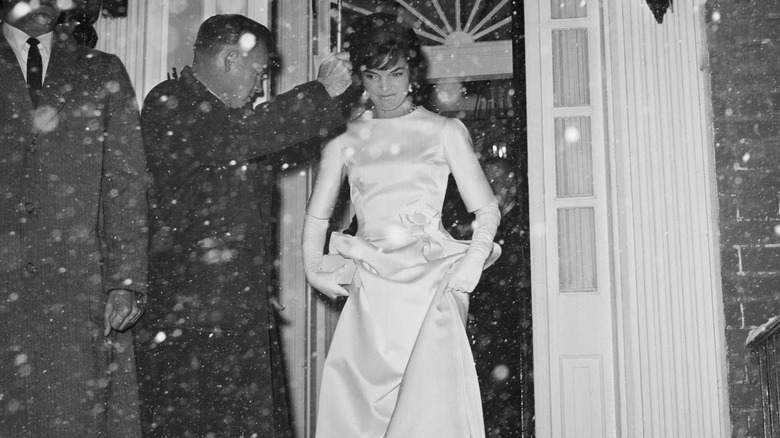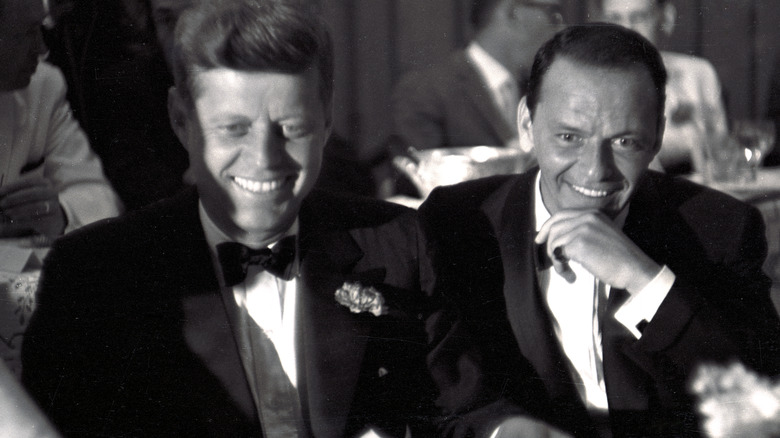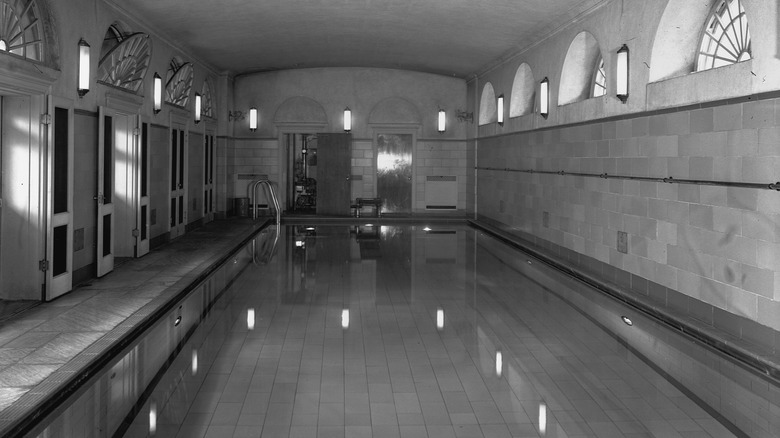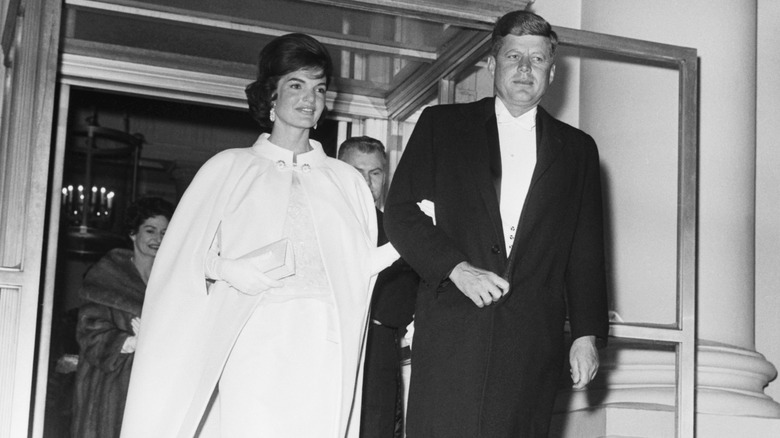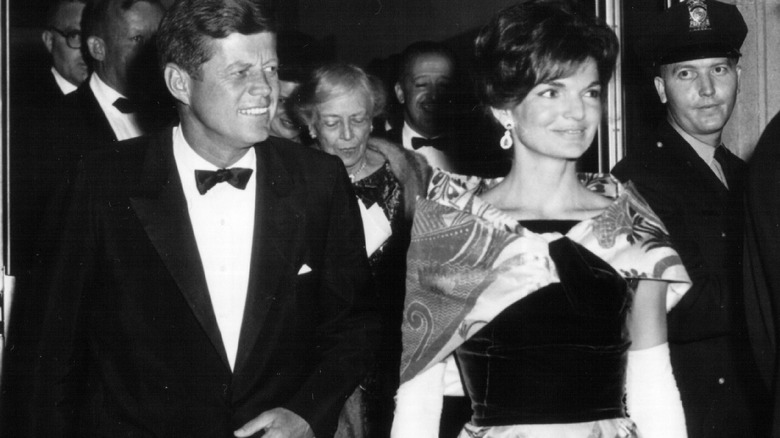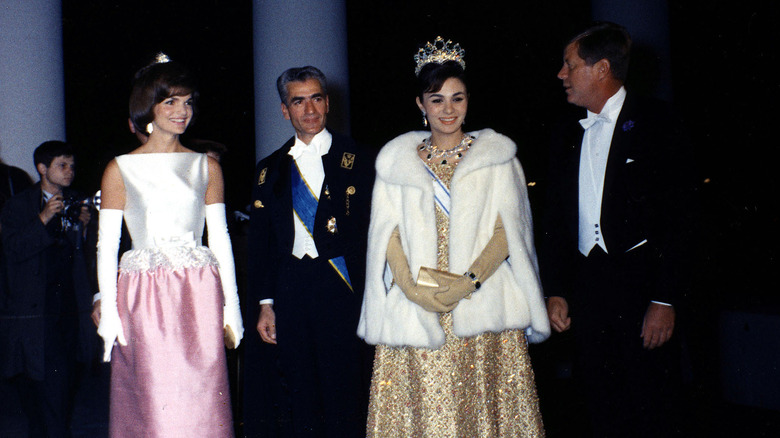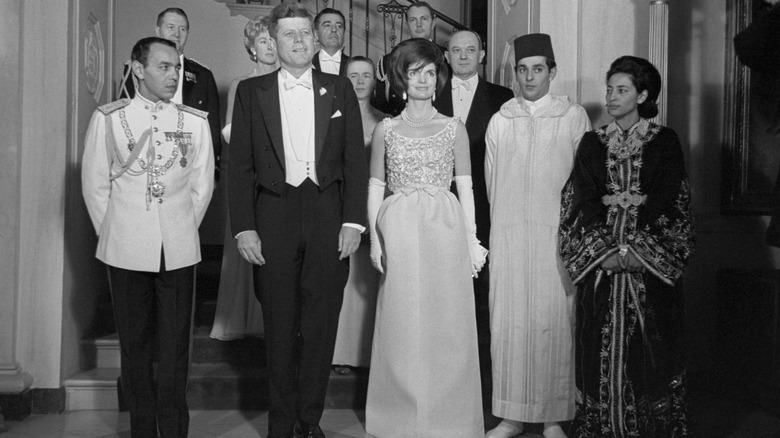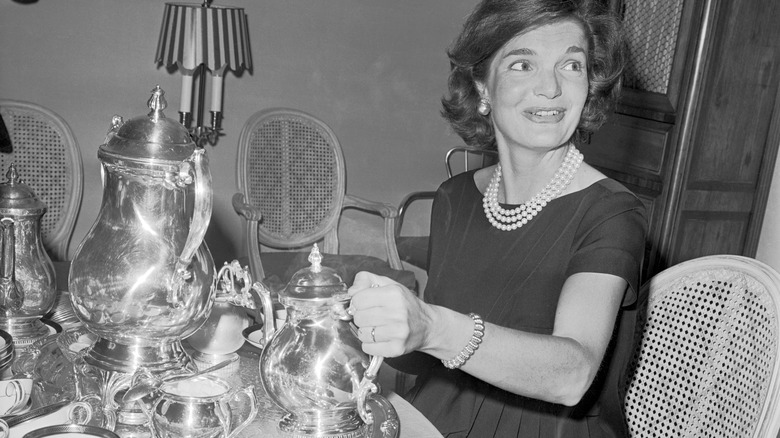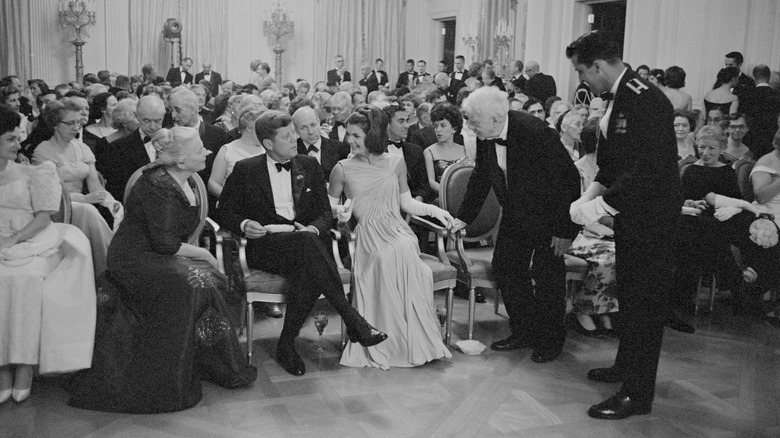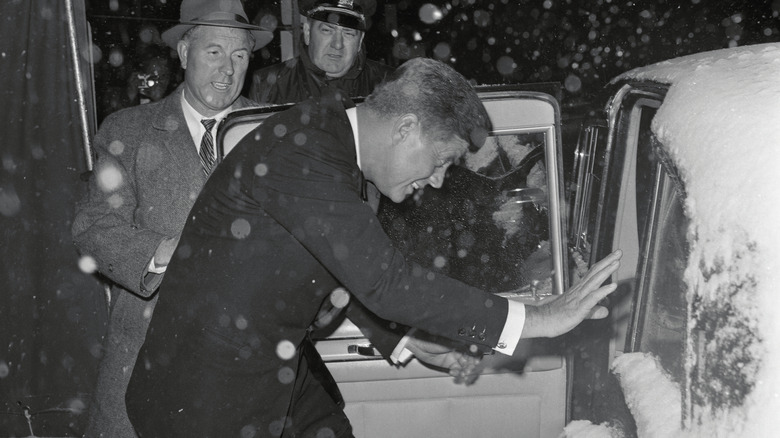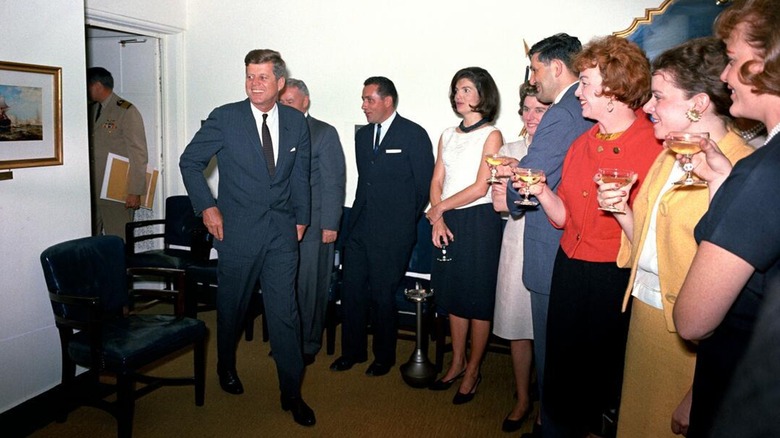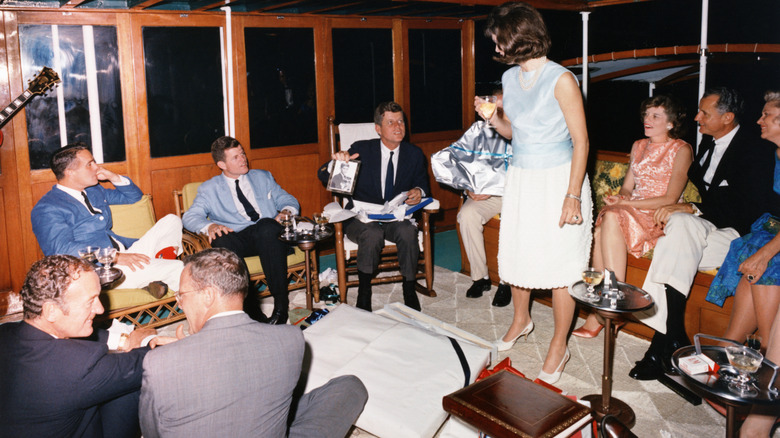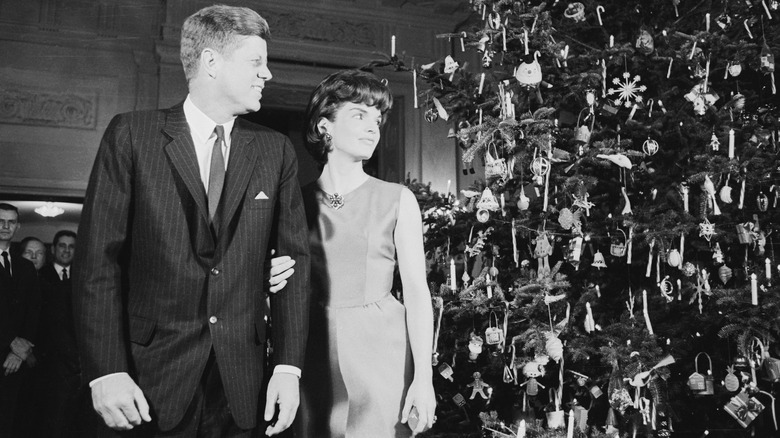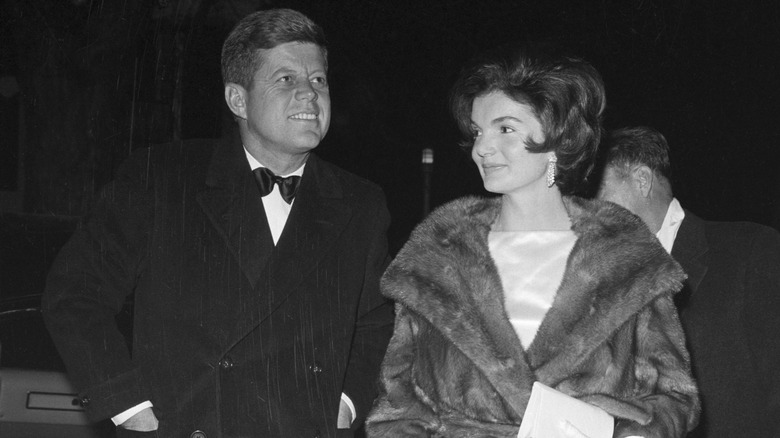What White House Parties During JFK's Presidency Looked Like
There are plenty of things that come to mind when the conversation turns to the Kennedy family. It might dissolve into assassination conspiracy theories, or it might turn into a conversation about what would have happened if the Cuban Missile Crisis hadn't played out quite like it did. But what about the fun stuff? What about the parties?
It turns out that there's a lot of fascinating stuff going on there, too. While John F. Kennedy was in the White House, there were, perhaps unsurprisingly, a lot of things going on behind closed doors. There's one bit of Kennedy history that honestly kind of sums up what one might expect from this particular presidency. The birthday that would be JFK's last — May 29, 1963 — was celebrated with a few different parties. One was a $1,000-a-plate dinner at the Waldorf Astoria, while another was a more personal gathering on a yacht. It included a who's-who list of Kennedy associates, including Mary Pinchot Meyer.
Meyer was reportedly one of JFK's many, many mistresses, and here's the weird thing: She was shot and killed in October of 1964, and her death remains an unsolved mystery. Reporter Lance Morrow was one of the first on the scene — ahead of even police — and wrote about the experience for Smithsonian. He says that some think her death had something to do with JFK's assassination... or her ex-husband's work with the CIA. That said, let's peek in and see what's behind some of those closed doors.
JFK's inaugural celebrations were a wild ride
Right from the very first day, John F. and Jackie Kennedy were going to make it clear that they knew how to throw a party. The night before Kennedy's inauguration, a massive gala was held that brought together everyone who was anyone at the time. There were plenty of politicians, sure, but there were also writers, artists, and one particular person for whom Jackie requested "the most VIP treatment": Diana Vreeland, the French-born fashion expert. Tom Wolfe of The Washington Post described it (via Vanity Fair) as "a 'gilt-edged, mink-lined, silk-hatted, 10-gallon, 100-proof' celebration."
First-hand accounts are fascinating: After a snowstorm threw the whole city into chaos and sent attendees scrambling to find creative ways to get there, champagne was served in paper cups, and the entertainment that unfolded included performances by Ethel Merman, Gene Kelly, Nat King Cole, Ella Fitzgerald, Milton Berle... the list goes on and on.
The inaugural celebrations sort of set the tone for the ones that would be held throughout JFK's relatively few years in the White House. There were plenty of drinks, mingling with the rich and famous, and Kennedy was quoted as saying, "There's an old saying that only in winter can you tell which trees are evergreen." He went on to say that the celebration — even in the face of the storm outside — "shows what kind of party we're members of." Hilariously, JFK was out partying until 3 a.m., which meant that the famous inauguration was done on just around four hours of sleep.
The inaugural celebrations were marred by controversy
When John F. Kennedy was elected, it's true that when he danced with a Black woman at his inaugural ball, it was a historic presidential first. Performers at the inaugural gala were integrated in a high-profile way, but it's also telling that there was one major exception that JFK may not have ordered, but still went along with.
The Kennedy connection with Frank Sintra and the Rat Pack is well documented, so it's not entirely surprising that Sinatra was there performing. On stage with him was Harry Belafonte, who later recounted, (via Vanity Fair) "The environment itself was as charged as any that I've ever known." But there was one person missing: Sammy Davis Jr., who had been removed from the guest list by Joseph P. Kennedy who was reportedly irate that he had married a white woman. Interracial marriages were still illegal in many places, and when Davis — who was a longtime, vocal supporter of JFK — married the actress May Britt, the elder Kennedy felt there was a massive problem with that.
Belafonte recalled, "It was one of those moments where not only was Frank not happy about it, the rest of us were put up against a moment where [we thought], 'How do we let this slide?'" Dean Martin's daughter later said (via Fox News) that Martin didn't attend the gala "because it was the right thing to do. ... This is Sammy Davis Jr. and that was his friend. And for family to not be invited for those reasons made my father very upset."
Pool parties were next-level... and didn't include Jackie
When the indoor pool was installed in the White House, it was for Franklin Delano Roosevelt's physical therapy and exercise. When John F. Kennedy stepped into the White House, it was the site of private pool parties that usually involved JFK, some of his closest male confidants, and a lot of young women.
The details of exactly what went on behind those closed doors are understandably scarce, but there are some things that have been leaked. Seymour Hersh is an investigative reporter and the author of "The Dark Side of Camelot," and he found that while there were regular attendees, there were so many women and indiscretions that one Secret Service agent, Larry Newman, told Hersch (via Newsweek), "We often joked that we couldn't even protect the president from getting venereal disease." And apparently, that was a staple at parties, too, along with — according to what former White House intern Mimi Alford wrote in her memoir, "Once Upon a Secret: My Affair With President John F. Kennedy and Its Aftermath (via The New Republic) — sex acts performed in front of others and on request.
In his book "Dog Days at the White House: The Outrageous Memoirs of the Presidential Kennel Keeper," Traphes Bryant wrote that he often saw various women escorted into the pool area... and he saw the chaos that descended ahead of Jackie Kennedy's surprise return one day. Confidants would scramble to clean up everything from highball glasses to naked frolickers, and Jackie was — in theory — none the wiser.
JFK's private parties caused strife with the Secret Service
Talking about what went on behind the closed doors of John F. Kennedy's White House with any real certainty is a little tricky. As Newsweek points out, there are a lot of wild claims, but some of the Secret Service agents who were on duty with JFK both at the White House and on the road have confirmed that his private parties presented a huge problem: They potentially put him in danger.
Larry Newman was one of Kennedy's Secret Service agents, and was among those who spoke with investigative reporter Seymour Hersch for his book, "The Dark Side of Camelot." He not only recalled (via Newsweek) how the party typically went on the road with Kennedy when he traveled, but added that Kennedy's personal aide, Dave Powers, was typically the one to give the all-clear to women who definitely hadn't been screened by Secret Service.
Newman has also been pretty upfront about how Kennedy's private parties wore on the agents assigned to protect him. "You were on the most elite assignment in the Secret Service... It just didn't compute. Your neighbors and everybody thought you were risking your life, and you were actually out there to see that he's not disturbed while he's having an interlude in the shower with two gals from Twelfth Avenue." Newman told Forbes that it became a running joke to debate who would be the one to testify if one of the women killed him.
Cocktails and controversies
There's a long history of American powers-that-be and alcohol. Just take the claim that a George Washington-hosted, Continental Congress-era party included 55 guests who polished off "54 bottles of Madeira, 60 bottles of Claret, 8 bottles of Whiskey, 22 bottles of Porter, 8 bottles of Hard Cider, 12 of Beer and seven bowls of Alcoholic Punch." And yes: USA Today's fact-checkers confirm that's legit. It's that context that makes it really surprising that Jackie Kennedy was the first to make it standard practice to have a fully stocked bar at White House parties.
The bar was in the State Dining Room, and in addition to the bar itself, Jackie also assigned White House butlers to bartending party duties. That's not only surprising in hindsight, but it was pretty shocking at the time — and according to The Washington Post, there was a massive backlash from a public that just couldn't fathom world leaders making decisions while attending events and getting — to use the scientific term — sloshed.
In 2020, the John F. Kennedy Presidential Library and Museum released letters condemning the widespread use of alcohol by the Kennedy White House and the establishment of the bar. One person wrote, "I think many feel humiliation and disgrace over our nation today when we learn of our White House turned into shameful drunken all-night carousal and dancing. Dignity previously engendered — gone. May God have pity on your poor soul." At the time, the Kennedy administration acknowledged the letters but pointed to other, more important matters at hand.
Were there drugs? Sources say yes
Here's a perfect example of how it's tough to find out just what went on in those ultra-private parties held behind the closed doors of the John F. Kennedy-era White House. In his book, "Party Like a President," Brian Abrams takes a look at stories of precisely that: closed-door parties (among other things). When it comes to JFK, Abrams says that of course there were all kinds of stories about mistresses and sexual indiscretions, but he also says (via Esquire) that drugs occasionally made an appearance, too.
He cites one instance where at least one intern was given amyl nitrite — poppers, which Medical News Today says are both sex enhancers and recognized as unsafe — and it sent the intern into a panic attack. Abrams also says that marijuana made at least an occasional appearance on the rotation, citing an instance where JFK reportedly passed on partaking of a fourth joint, saying, "Suppose the Russians did something now."
That said, it's also worth noting that when PolitiFact investigated Tommy Chong's claim that JFK regularly smoked pot in an attempt to alleviate the chronic pain he suffered as a result of a back injury and Addison's disease, they noted that while the pain was real, there was no evidence that marijuana was a regular thing.
Jackie Kennedy's dinner parties were elegant and groundbreaking
While there's a lot that's not known about John F. Kennedy's more private parties, there's more that's remembered about Jackie Kennedy's more public dinner parties. She's often credited for overhauling the way entertaining — especially in America's upper echelons — was done, and there's one big trend that she set.
For a long time, it was customary for men and women to split into two groups and two very separate rooms after a formal dinner party, but that wasn't the case in Jackie's White House: She served a post-dinner coffee where both men and women were welcome to sit together. When literary critic Diana Trilling wrote a piece for The New Yorker detailing every moment of a White House dinner party the Kennedys held for Nobel laureates, she wrote about being wildly impressed by the post-dinner coffee and reading done by Fredric March. After the reading, she and her husband, Lionel, retired to the Oval Room with a small group of guests: "We could scarcely talk to each other. We felt as if we were in a daydream."
Trilling also commented several times on the flowers: She noted, "Wherever there was a table or a shelf or a fireplace, there were magnificent flowers in soft arrangements." And that was actually done by design, and with the same ideas in mind as the co-ed mingling. Jackie, says House & Garden, designed her evenings to be gatherings where guests would be at home instead of uncomfortable.
Personal parties were less-than-serious
Parties in the Kennedy-era White House weren't always formal affairs. As the person responsible for the pets present during several administrations, Traphes Bryant had a unique insight into the goings-on at 1600 Pennsylvania Avenue. In his book, "Dogs Days at the White House: The Outrageous Memoirs of the Presidential Kennel Keeper," he wrote of a private birthday party that Jacke threw for one of her secretaries. They had both attended the Miss Porter School — which counted women from families like the Rockefellers, the Bushes, the Forbeses, and the Kelloggs among their alumni — and Bryant wrote that for one particular party, Jackie not only recruited the White House's Chief Usher to dress up in drag for the party and impersonate the house mother, but she recruited a Jackie look-alike, too.
That was a woman named Nancy Hough, who was reportedly renowned for her Jackie Kennedy impressions — both in person and on the phone. Attendees learned the school song, and Bryant says that it was a brilliant, hilarious, and much-needed success: Jackie was still grieving the death of her son, Patrick.
Bryant wrote that Jackie's sense of humor was present at most of the White House parties: "I doubt that any other First Lady was ever as playful or put on a better show at the White House then Jacqueline — whether it was coming up with a live monkey for Caroline's birthday party, or getting humans to make monkeys of themselves for her own party."
What's on the menu?
Diana Trilling wrote a review of a Kennedy party for The New Yorker, and said that guests were immediately greeted with "waiters carrying huge trays loaded with everything that one could possibly desire to drink: Manhattans, Martinis, highballs, sherry, tomato juice, orange juice." She went on to say that the atmosphere was so comfortable that everyone was acting — and drinking — like they were hanging out with some lifelong friends, and noted that they even held onto their drinks while standing in line to meet JFK. (Jackie would later get rid of the idea of these formal meet-and-greet lines.) Trilling also noted that the wine was all French, which was initially the case at all Kennedy-era White House parties.
According to The International Wine & Food Society, the Kennedy administration tried to keep their penchant for French wines on the down low, even asking reporters not to mention it in their event coverage. When that little tidbit of information inevitably got out, the Kennedys were careful to switch to California wines... or at least make them an option.
As for the food, the Kennedys hired Rene Verdon as the White House chef. His menus were credited with helping to popularize dishes like souffles and pate, but there's a footnote to this. Jackie Kennedy was almost surprisingly practical when it came to designing the menu: She insisted on affordability and a menu that was based around whatever foods were widely available, in-season, and personally tailored. Also? Party guests were treated to around four courses, several less than standard for other formal dinners.
1963's Emancipation Proclamation Party and a high-profile missing guest
Was there ever an intersection between party and policy? Absolutely, and that happened perhaps nowhere in a more high-profile way than the Kennedy administration's 1963 party to mark the 100th anniversary of Abraham Lincoln's Emancipation Proclamation.
Why? Sort of for the same reason Kennedy held the party in the first place. Journalist Simeon Booker told NPR that JFK was frustrated that he was a few years into his term and he hadn't hashed out an acceptable civil rights bill — and that's also why MLK decided to make a very loud statement by saying nothing much at all. As the story goes, MLK had first pitched the idea to Kennedy of writing a sort of Emancipation Proclamation not from slavery, but from segregation. JFK wasn't super enthusiastic and didn't even respond when MLK's camp wrote one up and submitted it to him. Booker explained, "[King and A. Philip Randolph] had no interest in attending a social event while younger Blacks, including college students, were being arrested in the South for violating Jim Crow laws."
Later, Jackie would be pitted against MLK again: Hoover's FBI would tell her wiretaps on King turned up all sorts of salacious activities — including comments supposedly made during JFK's funeral — leading to her taking a very defensive stance. Caroline Kennedy would later condemn (via ABC) Hoover's "poisonous... activities" as being the major source of the conflict and hostilities.
Official surprise parties were tame... but fun
Did John F. Kennedy know how to party for his birthday? Absolutely, but it seems as though the wildest parties didn't take place at the White House, but in various other places. That's not to say there weren't White House b-day parties: Photos of JFK's last birthday parties show a very different vibe based on where they were held. On May 29, 1963, at 5:45 p.m., White House staff kicked off a surprise party for their fearless leader. Photos show well-dressed, formal-looking staffers holding glasses of champagne, smiling as JFK played the ever-gracious role he was so famous for.
Secret Service Agent Clint Hill confirmed that he absolutely wasn't surprised when he walked into the gathering, held in the White House's mess — although he good-naturedly played along. It might not have been much of a surprise, but the cake itself may have made the whole thing worth it: It was prepared by the White House's personal French chef, Rene Verdon (via The Washington Post).
Hill said many of the gifts were gag gifts, and included things like boxing gloves — all the better to fight Congress with. He wrote that Jackie stole the show, though, when she presented him with some dead grass: "'Mr. President,' she deadpanned, 'on behalf of the White House Historical Society, it is with great honor and with the utmost respect that I present to you genuine antique grass from the antique rose garden.'"
Birthday parties went off-the-rails in private
While John F. Kennedy had a perfectly respectable, cake-filled party with his staff for what would be his last birthday, that was just the start of things. The real party reportedly happened later, when just a handful of the family's closest friends boarded a yacht and headed out.
That's where cocktails were served — along with a lot of 1955 Dom Perignon — and toasts were made, musicians serenaded with accordions and guitars, everyone danced the night away, and Ted Kennedy mysteriously ended up missing one pant leg and showing everyone what he was wearing underneath. The weather didn't cooperate but the rain only seemed to add to the fun, and everyone cut loose in a big way, to the point where Jackie's gift — a rare engraving — was trampled under the boot of a drunken reveler. Still, Clint Hill would later write (via The Washington Post) "I don't think I had ever seen the president and Mrs. Kennedy having more fun. Nobody wanted the night to end."
Was there a dark footnote to this? Yes: One guest — Antoinette Bradlee, who was then married to a prominent DC journalist who would become the editor of The Washington Post — recalled JFK chasing her into the bathroom, where he "made a pass. It was a pretty strenuous attack, not as if he pushed me down, but his hands wandered. I said, 'That's it, so long.' I was running like mad." Still, Hill remembered it as a good time: There were no politics, only friends, family, and a heck of a lot of drink.
Christmas parties were simple and elegant
It's no secret that every year when Christmas rolls around, one of the things that the White House does is unveil its theme for the year. When did that start? With Jackie Kennedy. According to The White House Historical Association, her Blue Room Christmas tree was decorated with a Nutcracker theme, kicking off the tradition that continues today. Decorations, they say, were not only simple, classic, and timeless — including holly, candy canes, and gingerbread cookies — but some were reused the next year. (That's also when she started the tradition of setting up a Nativity scene in the East Room.)
Kennedy Christmas parties weren't just restricted to the family, either. Seasonal festivities included staff parties filled with food, music, dancing, and gifts, and it was Jackie who headed off-grounds and visited other less fortunate children: In 1961, it was a children's hospital, and in 1962, she passed out candy to children at DC's Junior Village, built to house hundreds of the city's abandoned and unwanted children.
It's also worth noting here that in 1963, JFK and Jackie would spend their last night in the White House at a party. It was November 20, 1963, the reception was officially being held for members of the federal justice system, and alongside planning the party, they had already ordered and started to sign their Christmas cards... which would never be sent.
Jackie Kennedy was in her element while hosting
In a piece for The New Yorker, Diana Trilling wrote about how Jackie Kennedy made the party: She cited her effortless hosting and conversational skills, and her ability to make anyone feel like they were at home with some old friends... not hobnobbing with America's elite. Although her hosting skills were always impeccable, Trilling wrote that it was in the smaller, more intimate gatherings that she truly came alive.
"I began to understand that having this gathering in the Oval Room... was really Jackie's personal part of the evening. She had done her duty as a hostess, gone through the whole official occasion, and now it was her turn to have fun."
Trilling said that she came to understand that it was normal: After the big party with all the guests, some would be hand-picked and escorted into other rooms for more drinks and one-on-one conversation... and she believed that it was all Jackie's doing. And it was there that she told personal stories — including how she ended up getting Pushinka the Russian dog — and gave guests a peek into their private lives. Traphes Bryant, too, wrote about how she was the center of parties in his book, "Dog Days at the White House." He recalled seeing her "kick off her shoes while dancing under the chandelier in the main lobby," and circulating in a way that made everyone feel they were a close family friend.
